The Illustrated History of Dragon Ball
The whole Dragon Ball universe can't really be summed up in one word, but the single phrase I can think of to describe it is a multimedia phenomenon. Dragon Ball has been, in order, a manga, an anime, a series of movies, and and a universe of video games. This is probably confusing already, if this is the first time you've heard of the series.
 | The phenomenon began in 1984 when Akira Toriyama, a 29 year old manga artist with the success of his previous manga, Dr. Slump, under his belt, published the first issue of Dragon Ball. Dragon Ball featured a young boy with a monkey-like tail, named Son Gokuu after the protagonist in an ancient Chinese legend. Gokuu teamed up with Bulma, an ambitious, young, and temperamental girl, to find the seven Dragon Balls. |
| The Dragon Balls, however, weren't the focus of the comic. As Gokuu and Bulma explored the land and encountered different people with different problems, Dragon Ball became a story about characters instead of a story about a quest. In the first issue alone, we were introduced to Son Gokuu, Bulma, Kamesennin, Oolong, Yamcha, and Puuaru. It was the interaction between the characters, sparking conflict and humor, that made Dragon Ball a hit. It was such a hit that TOEI Animation came out with a Dragon Ball animated series, retelling the Dragon Ball story, which ran simultaneously with the manga. The television show was just as successful, as it managed to capture the humor and fun of the comic. | 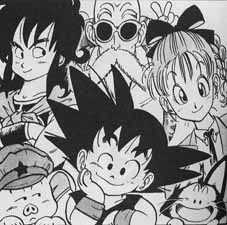 |
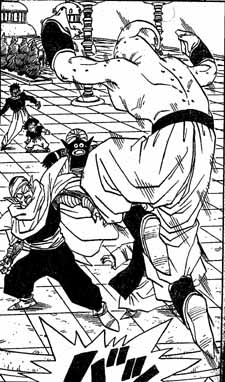 | The characters eventually almost completely superseded the Dragon Balls in terms of the plot. When Gokuu grew up, married and had a son, Gohan, the premise shifted from finding the Dragon Balls to defending the Earth against nasty aliens, the evil Saiyajins in particular. The tone of the series grew much more serious, and even the artistic style became less playful--straight, sharp lines and bold figures dominated, instead of the soft, round shapes from the earlier Dragon Ball. |
| If you thought that all the fighting in the Dragon Ball series would make it prime material for a video game, you were right! Bandai acquired the rights to make Dragon Ball video games, and in 1986, the first official Dragon Ball came out for the Famicom; it was called Dragon Ball: Shen Leung no Nazo (Dragon Ball: The Riddle of Shen Leung). The next decade saw no less than 22 Dragon Ball games, with the newest game, Dragon Ball GT, to come out this year. | 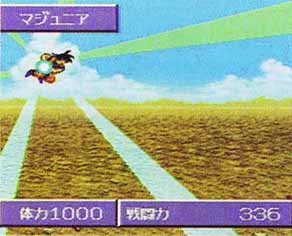 |
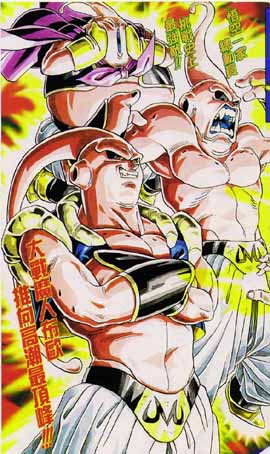 | When the Dragon Ball TV series ended, the manga was still as popular as ever, so a new Dragon Ball TV series was created--Dragon Ball Z. Even if you're relatively new to Dragon Ball, you're probably somewhat familiar with Dragon Ball Z. It is the longest of the Dragon Ball series so far, encompassing hundreds of episodes. It's also the most serious. All the plots dealt with the Z Team's attempts to protect the Earth from evil alien beings, from the Saiyajin pair Vegita and Nappa to the evil pink marshmallowy alien Majin Buu. Dragon Ball Z ended at the same time as the Dragon Ball manga (issue 42 was the last one), with an apocalyptic view of our home planet under the power of the evil Buu. |
| Dragon Ball fans weren't left in the dark for long, though. 1996 marked the beginning of Dragon Ball's newest incarnation, Dragon Ball GT. The first Dragon Ball TV series to be unaccompanied by a comic, Dragon Ball GT revived the old spirit and fun of the original Dragon Ball by turning Gokuu back into a young child, courtesy of the villain Pilaf. Together with his granddaughter Pan, grown-up Trunks (still very cute, but in a different way), and a loopy robot named Giru, Gokuu must travel through the galaxy in search of the black-starred Dragon Balls. | 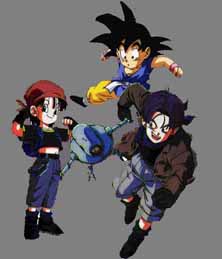 |
What will happen in the future of Dragon Ball? No one can say for sure, but your best bet for information is to keep visiting the Dragon Ball Kissaten! We always have a booth open, no reservations needed.
 | Click on Kintoun to return to the front door! |
Or return to the Information Desk.
E-mail me
This page hosted by
 Get your own Free Home Page
Get your own Free Home Page






